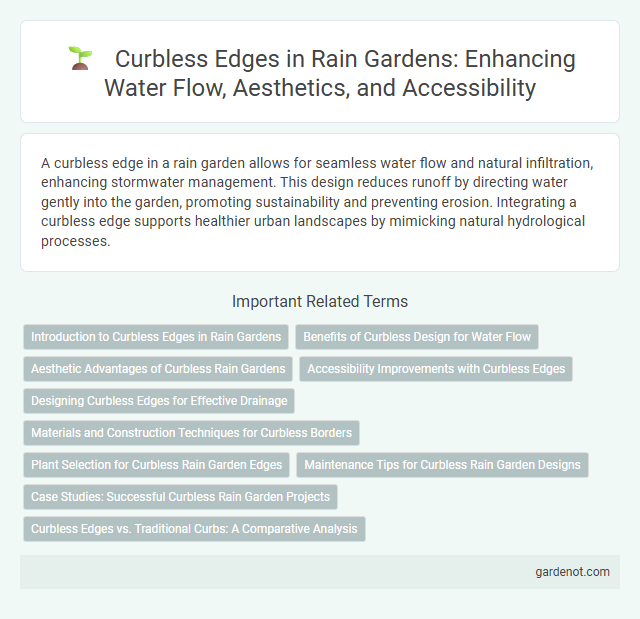A curbless edge in a rain garden allows for seamless water flow and natural infiltration, enhancing stormwater management. This design reduces runoff by directing water gently into the garden, promoting sustainability and preventing erosion. Integrating a curbless edge supports healthier urban landscapes by mimicking natural hydrological processes.
Introduction to Curbless Edges in Rain Gardens
Curbless edges in rain gardens enhance water infiltration by allowing rainwater to flow smoothly from surrounding landscapes into the garden without obstruction. This design reduces runoff and promotes efficient groundwater recharge, supporting stormwater management in urban areas. By eliminating traditional curbs, curbless edges also improve accessibility and create seamless transitions between hardscape and planted areas.
Benefits of Curbless Design for Water Flow
A curbless edge in rain gardens enhances natural water infiltration by allowing unobstructed flow from surrounding areas, reducing runoff and promoting groundwater recharge. This design minimizes erosion and pollutant accumulation by facilitating slow, even distribution of stormwater across the garden bed. Improved accessibility and seamless integration with landscapes make curbless rain gardens an effective and eco-friendly stormwater management solution.
Aesthetic Advantages of Curbless Rain Gardens
Curbless rain gardens enhance the visual appeal of outdoor spaces by creating seamless transitions between paved areas and planted zones, promoting a natural and inviting landscape design. This design removes harsh barriers, allowing for uninterrupted sightlines and a more organic flow that integrates with the surrounding environment. The minimalist edge effectively highlights native plants and water features, elevating the garden's overall aesthetic while maintaining functionality.
Accessibility Improvements with Curbless Edges
Curbless edges in rain gardens enhance accessibility by creating smooth, barrier-free transitions between sidewalks and green spaces, supporting wheelchair and stroller users. These sloped or flush designs improve safety by eliminating tripping hazards and facilitating easier navigation for individuals with mobility challenges. Incorporating curbless edges aligns with ADA standards, promoting inclusive urban environments and maximizing community engagement with sustainable stormwater management systems.
Designing Curbless Edges for Effective Drainage
Designing curbless edges for rain gardens enhances natural water flow by allowing stormwater to seamlessly infiltrate the soil, reducing runoff and preventing erosion. Incorporating gentle slopes and vegetation along the edges helps direct water efficiently while improving filtration and minimizing pooling. Proper grading and selecting permeable materials ensure optimal drainage performance and support sustainable urban water management.
Materials and Construction Techniques for Curbless Borders
Curbless edges in rain gardens commonly utilize permeable materials such as compacted gravel, decomposed granite, or concrete pavers to maintain water infiltration and prevent runoff. Construction techniques often involve precise grading to ensure proper water flow and the installation of underground drainage layers like perforated pipes or geotextile fabrics to enhance soil stability. Incorporating native soil amendments and erosion-control blankets further strengthens the curbless border, promoting sustainable water management and landscape integration.
Plant Selection for Curbless Rain Garden Edges
Selecting drought-tolerant, deep-rooted plants such as native grasses, sedges, and flowering perennials is essential for curbless rain garden edges to ensure effective water absorption and soil stabilization. Incorporating species like Carex spp., Echinacea purpurea, and Asclepias tuberosa enhances filtration capacity and supports local pollinators while preventing erosion along the garden's permeable boundary. Proper plant choices promote infiltration, reduce runoff, and maintain the structural integrity of curbless rain garden edges in urban stormwater management.
Maintenance Tips for Curbless Rain Garden Designs
Maintaining a curbless rain garden requires regular inspection to prevent soil erosion and ensure water infiltration remains effective, with mulch replenished annually to retain moisture and suppress weeds. Edge stabilization techniques like planting deep-rooted native vegetation help secure the garden's perimeter without the need for physical barriers. Clearing debris from the garden and adjacent drainage areas after storms promotes optimal water flow and reduces the risk of clogging or overflow.
Case Studies: Successful Curbless Rain Garden Projects
Curbless rain garden projects, such as Seattle's Beacon Hill and Portland's Tabor Commons, showcase effective stormwater management by allowing seamless water flow and infiltration without traditional barriers. These designs improve pedestrian accessibility while reducing runoff volume through native plants and permeable soils. Case studies demonstrate that curbless edges enhance urban sustainability and resilience by integrating green infrastructure into public spaces.
Curbless Edges vs. Traditional Curbs: A Comparative Analysis
Curbless edges in rain gardens enhance stormwater infiltration by allowing water to flow seamlessly into the garden without barriers, unlike traditional curbs that direct runoff to storm drains. This design promotes groundwater recharge, reduces erosion, and improves urban biodiversity by creating a more natural, accessible transition between pavement and vegetation. Compared to conventional curbs, curbless edges support sustainable water management and reduce maintenance costs associated with clogged drains and curb damage.
Curbless edge Infographic

 gardenot.com
gardenot.com